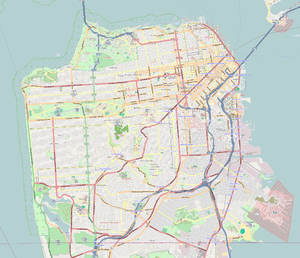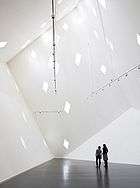Contemporary Jewish Museum
 | |
 Location within San Francisco | |
| Established | 1984 |
|---|---|
| Location | 736 Mission Street, San Francisco, California, United States |
| Coordinates | 37°47′09″N 122°24′14″W / 37.78577°N 122.40394°WCoordinates: 37°47′09″N 122°24′14″W / 37.78577°N 122.40394°W |
| Director | Lori Starr |
| Public transit access |
|
| Website |
www |
The Contemporary Jewish Museum (The CJM) was founded in 1984 in San Francisco, California. Its current mission is to make the diversity of the Jewish experience relevant for a twenty-first century audience through exhibitions and educational programs.[1]
History
The Contemporary Jewish Museum was founded in 1984 and was housed in a small gallery space near San Francisco's waterfront for over two decades. In 1989, the museum initiated a planning process to address the growing community need for its programs. The result was the decision to create a more expansive and centrally located facility with increased exhibitions, an area dedicated to education, and added program areas including live music, theater, dance, literary events, and film. In June 2008, the museum opened a new 63,000 square-foot facility in downtown San Francisco.
Exhibitions
The museum has no permanent collection. It curates and hosts a broad array of exhibitions each year. Since reopening in its new building in 2008, exhibitions have included:
- The 2015 Dorothy Saxe Invitational: Tzedakah Box
- Bound to Be Held: A Book Show
- Lamp of the Covenant: Dave Lane
- Letters to Afar
- Poland and Palestine: Two Lands and Two Skies
- In That Case: Havruta in Contemporary Art: Helena Keeffe and Jessica Prentice
- J. Otto Seibold and Mr. Lunch
- Arnold Newman: Masterclass
- In That Case: Havruta in Contemporary Art: Lindsey White and Ron Lynch
- Six-Word Memoirs on Jewish Life: Live from The CJM!
- Hardly Strictly Warren Hellman
- Project Mah Jongg
- Designing Home: Jews and Midcentury Modernism
- Arthur Szyk and Art of the Hagaddah
- Forever Now!
- Black Sabbath: The Secret Musical History of Black-Jewish Relations
- Frog and Toad and the World of Arnold Lobel
- To Build and Be Built: Kibbutz History
- Work in Progress: Considering Utopia
- Jason Lazarus: Live Archive
- Beat Memories: The Photographs of Allen Ginsberg
- StoryCorps StoryBooth
- Beyond Belief: 100 Years of the Spiritual in Modern Art
- Kehinde Wiley | The World Stage: Israel
- The Snowy Day and the Art of Ezra Jack Keats
- California Dreaming: Jewish Life in the Bay Area from the Gold Rush to the Present
- Stanley Saitowitz: Judaica
- The Radical Camera: New York's Photo League, 1936–1951
- Do Not Destroy: Trees, Art, and Jewish Thought
- Seeing Gertrude Stein: Five Stories
- Houdini: Art and Magic
- The Ping Pong Project
- Jacques Lipchitz: Hagar in the Desert
- Charlotte Salomon: Life? or Theatre?
- Are We There Yet?: 5000 Years of Answering Questions with Questions
- Curious George Saves the Day: The Art of Margret and H. A. Rey
- Reclaimed: Paintings from the Collection of Jacques Goudstikker
- Maira Kalman: Various Illuminations (of a Crazy World)
- Reinventing Ritual: Contemporary Art and Design for Jewish Life
- Our Struggle: Responding to Mein Kampf
- As It Is Written: Project 304,805
- There's a Mystery There: Sendak on Sendak
- Susan Hiller: The J.Street Project
- Chagall and the Artists of the Russian Jewish Theater, 1919-1949
- The Dorothy Saxe Invitational: New Works/Old Story: 80 Artists at the Passover Table
- Jews on Vinyl
- Dateline 09
- Warhol's Jews: Ten Portraits Reconsidered
- John Zorn Presents the Aleph-Bet Sound Project
- In the Beginning: Artists Respond to Genesis
- From The New Yorker to Shrek: The Art of William Steig
Programs
The museum’s education programs include public tours, classes and workshops, film screenings, lectures and gallery talks, performances, teacher training, school visits, family tours and art making, and a teen internship program.
Architecture
Daniel Libeskind designed the 63,000 square foot (5,900 square meter) museum, which occupies and extends the 1907 Jessie Street Power Substation, originally designed by Willis Polk. The building was completed in 2008. The museum cost $47.5 million to build. [2]
Design

The museum’s tilted, dark-blue stainless steel cube, constructed by A. Zahner Company, slices into the old substation’s brick, making visible the relationship between the new and the old. Libeskind’s design preserves the defining features of Polk’s old building, including its brick façade, trusses, and skylights. 36 diamond-shaped windows light the top floor of the metal cube, known as the Yud, which hosts sound and performance based exhibitions. The museum’s other section, a slanting rectangle known as the Chet, holds the narrow lobby, an education center, and part of an upstairs gallery.
Similar to Libeskind’s Danish Jewish Museum in Copenhagen, the Contemporary Jewish Museum incorporates text into its design. Inspired by the phrase “L’Chaim,” meaning “To Life,” Libeskind let the Hebrew letters that spell “chai” —“chet” and “yud,” inspire the form of the building.
Libeskind himself explains how he used the letters: “the chet provides an overall continuity for the exhibition and educational spaces, and the yud with its 36 windows, serves as special exhibition, performance and event space”.
.[3]
“To Life”, also a traditional Jewish drinking toast, refers both “to the role the substation played in restoring energy to the city after the 1906 earthquake and the Museum's mission to be a lively center for engaging audiences with Jewish culture.”.[4]
The Hebrew word pardes, meaning “orchard,” is embedded in the wall of the lobby.
The building also houses a multi-purpose event space, an auditorium, Wise Sons Deli, and a museum store. [5]
Reaction
Critic Christopher Hawthorne of the Los Angeles Times praised Libeskind for a “careful balance of explosive and well-behaved forms” and gallery designs that abandon the architect’s characteristic slanted walls. Likewise, David D’Arcy of the Wall Street Journal sees the museum as a laudable departure from Libeskind’s previous work. He finds a “lightness to this [museum] that is rare in the architect’s work” and that “relieves the surrounding district’s glass and steel tourist-mall monotony.” [6]
Management
Former Whitney Museum curator Connie Wolf was the museum’s director from 1999 to 2012. Lori Starr, former executive director of the Koffler Centre of the Arts (Toronto, CN), was appointed the museum's director in 2013.[7] In 2014, the museum hired Renny Pritikin as Chief Curator. [8] In 2015, the museum hired Anastasia Rygle as Associate Curator. [9]
See also
References
- ↑ Contemporary Jewish Museum. "History and Mission". Retrieved 2008-07-25.
- ↑ Los Angeles Times. "Slash and yearn". Retrieved 2014-04-29.
- ↑ Bianchini, Riccardo. "San Francisco - Contemporary Jewish Museum by Daniel Libeskind". Inexhibit. Retrieved 2015-09-13.
- ↑ Contemporary Jewish Museum. "The Building". Retrieved 2015-09-13.
- ↑ San Francisco Chronicle. "Deli to open in Contemporary Jewish Museum". Retrieved 2013-06-04.
- ↑ Los Angeles Times. "Slash and yearn". Retrieved 2014-04-29.
- ↑ Art Daily. "Lori Starr appointed Executive Director of San Francisco's Contemporary Jewish Museum". Retrieved 2014-04-29.
- ↑ Artinfo. "SF's Jewish Museum Names New Chief Curator". Retrieved 2014-04-29.
- ↑ Artdaily. "Anastasia Rygle appointed Associate Curator at The Contemporary Jewish Museum in San Francisco". Retrieved 2016-02-25.
External links
| Wikimedia Commons has media related to Contemporary Jewish Museum. |
- Official site
- San Francisco Chronicle article about new facility
- Los Angeles Times article about the groundbreaking
- San Francisco Business Times on Executive Director Lori Starr
- SF Gate article about Chief Curator Renny Pritikin
- SF Weekly article about Dave Lane's "Lamp of the Covenant"